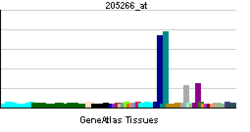From Wikipedia, the free encyclopedia
Leukemia inhibitory factor, or
LIF, is an
interleukin 6 class
cytokine that affects
cell growth by inhibiting differentiation. When LIF levels drop, the cells differentiate.
Function
LIF derives its name from its ability to induce the terminal
differentiation of
myeloid leukemic
cells, thus preventing their continued growth. Other properties
attributed to the cytokine include: the growth promotion and cell
differentiation of different types of target cells, influence on
bone metabolism,
cachexia,
neural development,
embryogenesis and
inflammation.
p53 regulated LIF has been shown to facilitate
implantation in the mouse model and possibly in humans.
[1]
It has been suggested that recombinant human LIF might help to improve
the implantation rate in women with unexplained infertility.
[2]
Binding/activation
LIF binds to the specific LIF
receptor (
LIFR-α) which forms a
heterodimer with a specific subunit common to all members of that family of receptors, the
GP130 signal transducing subunit. This leads to activation of the
JAK/
STAT (Janus kinase/
signal transducer and activator of
transcription) and
MAPK (
mitogen activated
protein kinase)
cascades.
[citation needed]
Expression
LIF is normally expressed in the trophectoderm of the developing embryo, with its receptor LIFR expressed throughout the
inner cell mass.
As embryonic stem cells are derived from the inner cell mass at the
blastocyst stage, removing them from the inner cell mass also removes
their source of LIF.
Use in stem cell culture
Removal of LIF pushes stem cells toward
differentiation, but they retain their proliferative potential or pluripotency. Therefore LIF is used in mouse embryonic
stem cell
culture. It is necessary to maintain the stem cells in an
undifferentiated state, however genetic manipulation of embryonic stem
cells allows for LIF independent growth, notably overexpression of the
gene
Nanog.
LIF is not required for culture of human embryonic stem cells.
[3][4]
==================================================================
These comments from Wikepedia introduce our discussion today,
first of all, patient with leukemia have their cells stopped at various stage of differentiation
meaning some are stopped at baby stage, some at teenager stage, some at adult stage. And at each stage, the leukemia takes a different Name, agressiveness and prognosis. In General, the younger the stage the bad/worse the prognosis. So there is a benefit to HELP ALONG THE CELL TO GROWTH, IT ACTUALLY IS HELPFUL FOR THE CELL TO MATURE SO THAT THE TUMOR GETS A GOOD OR BETTER PROGNOSIS.
AS A MATTER OF FACT, THE MORE MATURE THE CELL BECOMES, THE LESS LIKELY IT WILL DIVIDE REDUCING THE LOAD OF THE TUMOR. THE MORE MATURE IT GETS, THE MORE LIKELY IT WILL GET OLD AND DIE OF A NATURAL DEATH.
ON THE OTHER END HOWEVER, THE MORE LIKELY IT MATURES, THE MORE LIKELY IT MAY COMPLETE OR PERFORM ITS NATURAL FUNCTION. SO IF ITS FUNCTION WAS TO BE ABLE TO SPREAD, THE MATURE CELL CAN SPREAD FASTER. THAT'S WHY SCIENTISTS ARE REPORTING THAT AN INHIBITOR TO THIS LIF MAY STOP THE SPREAD OF CANCER. THE MD ANDERSON HAS BEEN WORKING ON THIS AND HAVE REPORTED SOME SUCCESS! THE FIGHT IS ON!


